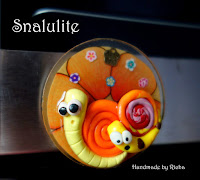And on to Part 2,
I am rewriting this part because I, like a klutz deleted this entire part, one whole hour wasted! You may be wondering if the second part will introduce techniques, the answer is no! Those can be acquired in time, I am trying to find my own reasons for Polymer clay other than the fact that it gives me immense pleasure!
Taking it forward from the last article about Polymer clay, if you haven't read it... here is the link.
http://richarps.blogspot.in/2015/11/oven-craft.html
Since I extensively delve in Paper, beaded and Polymer clay Jewellery, I am going to try and find my sweet spot. Polymer clay and Paper in this instance have much more similarities than beaded, I am going to go into my reasons for those.
I am rewriting this part because I, like a klutz deleted this entire part, one whole hour wasted! You may be wondering if the second part will introduce techniques, the answer is no! Those can be acquired in time, I am trying to find my own reasons for Polymer clay other than the fact that it gives me immense pleasure!
Taking it forward from the last article about Polymer clay, if you haven't read it... here is the link.
http://richarps.blogspot.in/2015/11/oven-craft.html
Since I extensively delve in Paper, beaded and Polymer clay Jewellery, I am going to try and find my sweet spot. Polymer clay and Paper in this instance have much more similarities than beaded, I am going to go into my reasons for those.
Paper VS Polymer clay
Both these mediums have their advantages and disadvantages.
1. Flexibility : PC lends into to very curvaceous patterns for the base, where as paper has limited ability as stand alone curves. For example: PC can be used for Bracelets with ease, paper is restricted in that aspect to charms. Figurines have better finishes with PC if made sturdy enough. We can at times just sculpt out clay when in need of a depression, or add clay to give mounds, alternatively we can use 3D bakeable surfaces like glass bowls to make a rounded surface. Although paper, quilling lends itself to be made into curved surfaces, the shapes and sizes possible are limited. However we can use 3D outliners, embossing inks to create 3D patterns on paper. Where you need to make a provision for hooks , pins etc in paper pendants and earring pieces while laying the layers of the paper, one can drill a hole in PC ( preferably pre baking). Post baking, the strength of the piece may be compromised in the process, where paper once layered is a solid unbreakable piece!
2. Minute detailed work: Going in the favour of paper, it lends itself to finer work as compared to PC. While you can use an extruder for the fine details in PC, it still cannot compare to the finesse of work possible with Paper. Picture transfer onto PC is possible, but is a painstaking process with expensive additional accessories.
3. Longevity: PC comes in a range of ready colours, which are long lasting. Paper can hold its own with the use of acrylics/ Oil/ distress inks etc for colour, but it needs some help. PC can withstand aging better without much post processing, where as paper would ideally need something like varnish, glass or resin to protect it.
4. Time: Once PC pieces are made and additionally it is baked within 30 minutes to an hour. The post processing like sanding, buffing, glazing will maybe take another half an hour. The time taken to make the piece is not constant and depends on the kind of work required..PC piece can be ready within X+ 1 hr. In paper one can require anywhere from 1 hour to 24 hours for post processing. Paper unfortunately has the uncertainty depending on the type of post processing we are doing, resin ( at-least 24 hrs recommended 72hrs) / Mod-podge ( hard finish- 72 hrs), varnish ( 30 minutes-1 hour). Paper sometimes may need part by part work which may extend the worktime. PC may need multiple baking steps too.
5. Sturdiness : Paper is sturdy by itself when layered right! To protect the design, we need to include resin and we are set. PC unfortunately can be broken and is prone to chipping where there are delicate pieces involved. PC has its own version of resin which hardens when baked, but it does not work as effectively as resin does for paper.
6. Cost: The main difference that could make or break an order is, and always will be cost. Where PC races ahead for most of the aspects, Paper wins this one hands down. PC needs a lot of tools and accessories, even with basics, the initial cost of investment is higher than that of Paper. With extras it is even more so.
Mixing Mediums: PC and Paper
 |
| PC on Paper |
 |
| Paper on PC |
Since I compared the two mediums individually, I was further curious to see if they work well together. Can the weaknesses of one be turned to an advantage,?
As it turns out yes.
On one side it will be profitable for the paper based jewellery to use PC as cabochons as a center piece, which gives it a 3D effect too. This is a value addition for fraction of the cost of a full fledged PC piece. This works well for customised pieces, with a tight budget. Another way to cash in on the finesse aspect, is to encase paper with a design on it with liquid polymer clay and bake it or make a polymer clay decorative base with the dimensions of the designated design on paper , bake the base separately and then insert the design paper into the PC casing and use resin to seal it off.
When you are narrowing down on the design selection, make sure you touch all the points above or a combination of them, as per your clients wishes, to make the final call.
If you can think of any additional concerns, do leave them in the comments. :)
Polyclay in love
~Richa

No comments:
Post a Comment